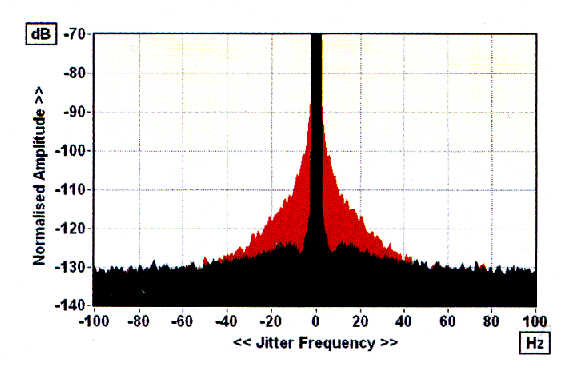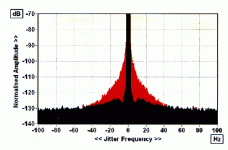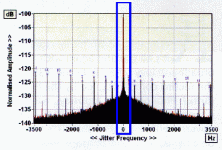Frankly, do you find efforts like this any useful, other than engineering feeling of killing some barriers? No one would hear non-linear distortion below 0.01%, provided it is not a cross-over like distortion with spectrum to infinity, and even then it would be difficult to tell it by listening.
Absolutely not. The PGP was purely a “because I can” type of project, nothing more or less. The lessons learned (EC, how to apply NDFL, the importance of wiring and magnetic effects, etc...) were eventually very useful, though.
Last edited:
Joe/mmerrill99, which makes/model of supercaps have you experimented with and what subjective changes have you noted ?.
Joe, what do you think is happening ?
Dan.
I have some KAMCAP Supercaps here 0.33F 5.5V and datasheet:
http://tinkersphere.com/documents/1F55VSupercapacitor_Datasheet.pdf
The specs are very typical and similar to others of various brands I have tried, like those readily available on eBay.
The rated ESR is 44R and I measured a 79mA initial peak when connected to +3.3V and that coincides well as 3.3/44=0.075 (75mA). But no power supply comes on instantly so I suspect that charging up the reservoir caps just after the rectification means that the 79mA is not actually reached. So far I have used/done this hundreds and hundreds of times and there has been zero failures.
Since the ESR value is high in supercaps, I believe that the energy stored and that ESR means that the benefit is down to a fraction of a Hertz' with low rate of change (did somebody just refer 1/f noise). Paul Miller in the UK has referred to "Uncorrelated Noise-Like Jitter" and came up with the measurement below, note the high magnification required.

People here can make up their own mind. But what is so obvious is anybody can try it, since you can buy these 0.33F/5.5V supercaps all over the place now. Put on the power supplies of DAC and the usual =3.3V on the oscillator (assumes that it is a powered oscillator). Then you can comment on what you think is happening and what it does to the sound. Fair enuff?
1 PCs CAPACITOR SUPER .33F 0.33F 5.5V SUPERCAP Radial SUPER Cap | eBay
[Edit: Seems something wrong is happening to the above link, so will also attach below.]
Attachments
Last edited:
Since the ESR value is high in supercaps, I believe that the energy stored and that ESR means that the benefit is down to a fraction of a Hertz' with low rate of change (did somebody just refer 1/f noise).
I will continue this discussion with my neighbours cat.
😀 I've never used it, even after being trolled and falsely accused by the usual suspects, they all have very similar methods have you noticed? 🙄
Yeah, don't see the need for the ignore list... A glance and then read or scroll... Everyone says good and bad things sometimes; but even in the most acrimonious exchanges here there's usually some titbits of interesting stuff. Or just entertainment! 🙂
Cool thanks, seemed like a ‘sleeper’ and they don’t sling anything but facts on their website....no fluff!
See:
Review and Measurements of RME ADI-2 DAC | Audio Science Review (ASR) Forum
Review and Measurements of RME ADI-2 Pro (comparison to ADI-2 DAC) | Audio Science Review (ASR) Forum
and:
Master Index for Audio Hardware Reviews | Audio Science Review (ASR) Forum
There is several things interesting, about output coils in amplifiers. Yes, they help the stability margin. Yes they can bring some negative impact by electromagnetic coupling: It is interesting and easy to find the best physical place and orientation in an amp to minimize-it. The second thing is they help to reduce RMI/RFI entering in the amp by its feedback network. Here too, it seems to me a good idea to have them situated as close a possible to the output plug (IE the input for the feedback) and as far from the input lines as possible. Lot of people have them on the printed circuit: it is sub optimal, so, a design mistake that have more impact that their value. Agree ?Do you have information how much the value of the coil inductance change that influence? I use 0.5uH up to 1uH as I try to design an amp to be stable on capacitive load with that values.
I wonder why a lot of EE in audio is so much in concern with harmonic distortion like if it was the main factor influencing our listening experience. It is enough to listen to some tube amps, with a lot higher level of them, that sound more transparent and euphonic than their solid-state counterparts, to think we should focus more on other aspects. Like IM and dynamic behaviors ? Your remark about the spectrum of HD is interesting. I hardly believe we should be able to listen to HD components lot higher than our ears bandwidth capabilities. Especially with the mask effect. So, if we can feel a difference, it is probably somewhere else.No one would hear non-linear distortion below 0.01%, provided it is not a cross-over like distortion with spectrum to infinity, and even then it would be difficult to tell it by listening.
Oh my Professeur, don't let them influence your manners and choice of vocabulary. A learned gentleman avoids using less than civilized words. 😀Now, you gona be "routed to /dev/nul". But do not worry, in fact, it's lot better.
when being near rabid animals, better to be on the other side of the fence.
There is several things interesting, about output coils in amplifiers. Yes, they help the stability margin. Yes they can bring some negative impact by electromagnetic coupling: It is interesting and easy to find the best physical place and orientation in an amp to minimize-it. The second thing is they help to reduce RMI/RFI entering in the amp by its feedback network. Here too, it seems to me a good idea to have them situated as close a possible to the output plug (IE the input for the feedback) and as far from the input lines as possible. Lot of people have them on the printed circuit: it is sub optimal, so, a design mistake that have more impact that their value. Agree ?
I wonder why a lot of EE in audio is so much in concern with harmonic distortion like if it was the main factor influencing our listening experience. It is enough to listen to some tube amps, with a lot higher level of them, that sound more transparent and euphonic than their solid-state counterparts, to think we should focus more on other aspects. Like IM and dynamic behaviors ? Your remark about the spectrum of HD is interesting. I hardly believe we should be able to listen to HD components lot higher than our ears bandwidth capabilities. Especially with the mask effect. So, if we can feel a difference, it is probably somewhere else.
I tend to put the output coil off the power board close to the output terminal and make provision for both possibility. As this is DIY even if the coil is layout on the board it's easy to move it off, and make short on the board. Tournesol quote: "It is enough to listen to some tube amps, with a lot higher level of them, that sound more transparent and euphonic than their solid-state counterparts,"
Maybe euphonic but not transparent.
Thank you to support some of my views, but be just less aggressive to some participants here, always to learn more from them.
I wonder why a lot of EE in audio is so much in concern with harmonic distortion like if it was the main factor influencing our listening experience..
Because specs sell and that is the one people measure and post.
Because specs sell and that is the one people measure and post.
Yeah, and it can be a lazy shortcut / proxy for inference. Especially if at a higher frequency than the usual 1 kHz. A possible indicator, if you want to call it that because so few manufacturers publish anything better.
You are right, please consider i'm just an imperfect human being (hard to stay a gentleman in a street fight) and accept my apologies.Oh my Professeur, don't let them influence your manners and choice of vocabulary. A learned gentleman avoids using less than civilized words. 😀
I have a question in my mind this morning. A little philosophical, as habit.
We often consider our electronic circuits as directly responsible, by their various distortions, of the sound quality.
We just forget that an amp is just there to excite a speaker's membran. That is a resonant very complex mechanical system we know little about.
Because my poor English, I will try to make an image.
Considering an amp + the moving coil like the chords on a guitar, and the speakers membranes like the resonnant table, It is not the "sound" of the chord itself that matter the most.
Depending of the way the chord is attacked (dynamic), and its harmonic content (position of the nail/plectre) it will excite the table of the acoustic instrument in very different ways. And, with two different instruments the relative result will more important that the sound of the chord itself (that is very low, if you mount the chord on a non resonant plate).
The "sound" of an amp is not something we can consider as absolute (like it is described by audiophile reviews). The same amp A that is 'dynamic' on a given speaker can be 'slow' on an other and the contrary for an amp B.
Considering only the Harmonic distortions and even the IM (IE the measuring numbers) as responsible of the result (our listening experience) seems to me a total abusive simplification.
Reason why I consider "listening" as the only way to try to figure out what we will....'listen'.
Yes it can be flawed by our personal subjectivity, culture, influences etc... yes, it is less objective than electronic measurements ... But those measurements are not so talkative when it is about the highly complex electrical/acoustical interfaces.
All this war between objectivist/ VS subjectivist, or what people believe others are, is a stupid nonsense, on my point of view.
Neglecting the objective measurements is a big mistake, no need to explain why, believing they tell everything as well. We have to be very modest about what we know about what's happens in a given so complex system.
And consider others ways to explore with interest and respect, even if we experience opposite effects: no system is the same in two different places.
Supercaps in DACs ? Why not. The important questions are "why and how ?".
Accusing someone that tried and found a difference to be influenced by the word "super" is, how to say ... ?
It just made me want to try. If it brings an improvement, it will be time for me to ask the question of why, and, otherwise, to drop without generalizing my personal experience as one of the laws of the universe.
mmerrill99 said:. . . stop off in the psychiatry dept first - I'm sure they'll find you fascinating
This is reasoned technical discussion where you come from?The guy was obviously a backroom techy & should never be allowed out in public with his zero social skills
It does not matter whether someone knows what chemical noise is or not; if measurements show that the noise from a battery can be fully explained by Johnson/thermal noise then there is no chemical noise from that battery.
Always these nebulous "interactions". Very useful for FUD purposes. Yet the obvious 'interaction' between a regulator (with typically inductive output impedance) and a big cap does no harm?why I say stability (less interaction between battery & device being powered) seems to me to be also in the mix (probably other factors at play too?).
Always "something deeper". It is clear that the little red gremlins inside the regulator reach out across the circuit to talk to the little green gremlins in the load (DAC, perhaps) and sometimes they get on well and sometimes they have a fight. Of course, as soon as a test probe appears all the gremlins start behaving properly so all the naive conventional engineer sees is boring stuff like output impedance and noise (both as a function of frequency). Pull the probe away and the gremlins start arguing again.As I said the noise thing is just the visible indication of something deeper going one - settling time? transient response?
I will continue this discussion with my neighbours cat.
Wow! Your neighbour must have an intelligent cat. 😉
Do not take this for an attack (it is not at all), but, in matter of audio, I don't know the meaning of the word "transparent". Never found something like this. Do-you mean "convincing" ?Maybe euphonic but not transparent.
...
Thank you to support some of my views, but be just less aggressive to some participants here, always to learn more from them.
About the second point, Yes, I try. But really, I'm upset by such an aggressivity and prone to lose my temper.
Pearl harbour explain the Hiroshima abomination. But, you are right, don't excuse-it.
I appeal to your indulgence and your understanding. I can be violent because i'm fragile or too sensible.
My only interest is, like you, to learn more.
I never learned anything from people who, pretending to be a teacher (diploma or not), were martyring their students and reigning terror.
Between you and me, and as a personal remark, I'll like to say that I look at your works with a great interest. But It is not because I support your views (while it can happens) - I do not consider mines as a reference, even for me - it is because I share your curiosity and desire to explore. And, of course, I find you technically "correct", (to say the least), often subtil or elegant, on the few point I think to know or have experienced.
The way S..08 had attacked both of us (and many others i like) was totally unacceptable. Even on a pure technical point of view. He is now in my ignore list.
The worse, for me, is when somebody accuse-you to share your work. "Self promoting" a non commercial open source free offer ? On a DIY forum ?
What else are-we supposed to do ?
Last edited:
Do not take this for an attack (it is not at all), but, in matter of audio, I don't know the meaning of the word "transparent". Never found something like this. Do-you mean "convincing" ?
In audio transparent for me means what goes in goes out unchanged.
Most tube amps are like tinted glass, can change some lights to be nicer.
My design goal in audio to be like transparent glass, not tinted.
Last edited:
Transparency is very important, especially for those of us who listen to classical music and have some idea how it should sound when reproduced by an audio system. This is not necessarily the case for artificial/amplified/electronic music, where no one knows how it should sound and euphonic distortion of valve power amps or simple ZEN amps may be welcomed by some. Not me in this group.
Part of the problem is the lack of work done on measurement, analysis and interpretation of the actual sound reaching the listener. Most distortion and other measurements are focused only on the electrical side. And then there are pinnae transformation and psychoacoustic on top of it. 🙂... All this war between objectivist/ VS subjectivist, or what people believe others are, is a stupid nonsense, on my point of view.
Neglecting the objective measurements is a big mistake, no need to explain why, believing they tell everything as well. We have to be very modest about what we know about what's happens in a given so complex system.
And consider others ways to explore with interest and respect, even if we experience opposite effects: no system is the same in two different places.
....
As Pavel mentioned, there is a significant difference between a live performance and recorded. Seems there should be venues to pursue for meaningful progress. I think it is not yet time to give up.
It was maintained here that batteries were only for portability, not for low noise & that regulators are as good as if not lower noise than batteries/supercapacitors
Now that we have a number of reports showing measurements that directly contradict these assertions, the debate shifts to accusations of FUD
Some people can't seem to live with not yet knowing what's behind an easily observable fact & they are not curious enough to try it themselves, preferring the usual argumentum ad infinium
Now that we have a number of reports showing measurements that directly contradict these assertions, the debate shifts to accusations of FUD
Some people can't seem to live with not yet knowing what's behind an easily observable fact & they are not curious enough to try it themselves, preferring the usual argumentum ad infinium
The main reason mentioned was to cut any path to parallel ground returns even the capacitive coupling. Not the portability.
Exactly right. ToS has discovered when almost everyone is on his ignore list he can't follow any discussion. 🙄Yeah, don't see the need for the ignore list... A glance and then read or scroll... Everyone says good and bad things sometimes; but even in the most acrimonious exchanges here there's usually some titbits of interesting stuff. Or just entertainment! 🙂
I kind of agree, wish I could enjoy a system with less than 0.1% thd. 🙂Transparency is very important, especially for those of us who listen to classical music and have some idea how it should sound when reproduced by an audio system. ...
- Status
- Not open for further replies.
- Home
- Member Areas
- The Lounge
- John Curl's Blowtorch preamplifier part III

